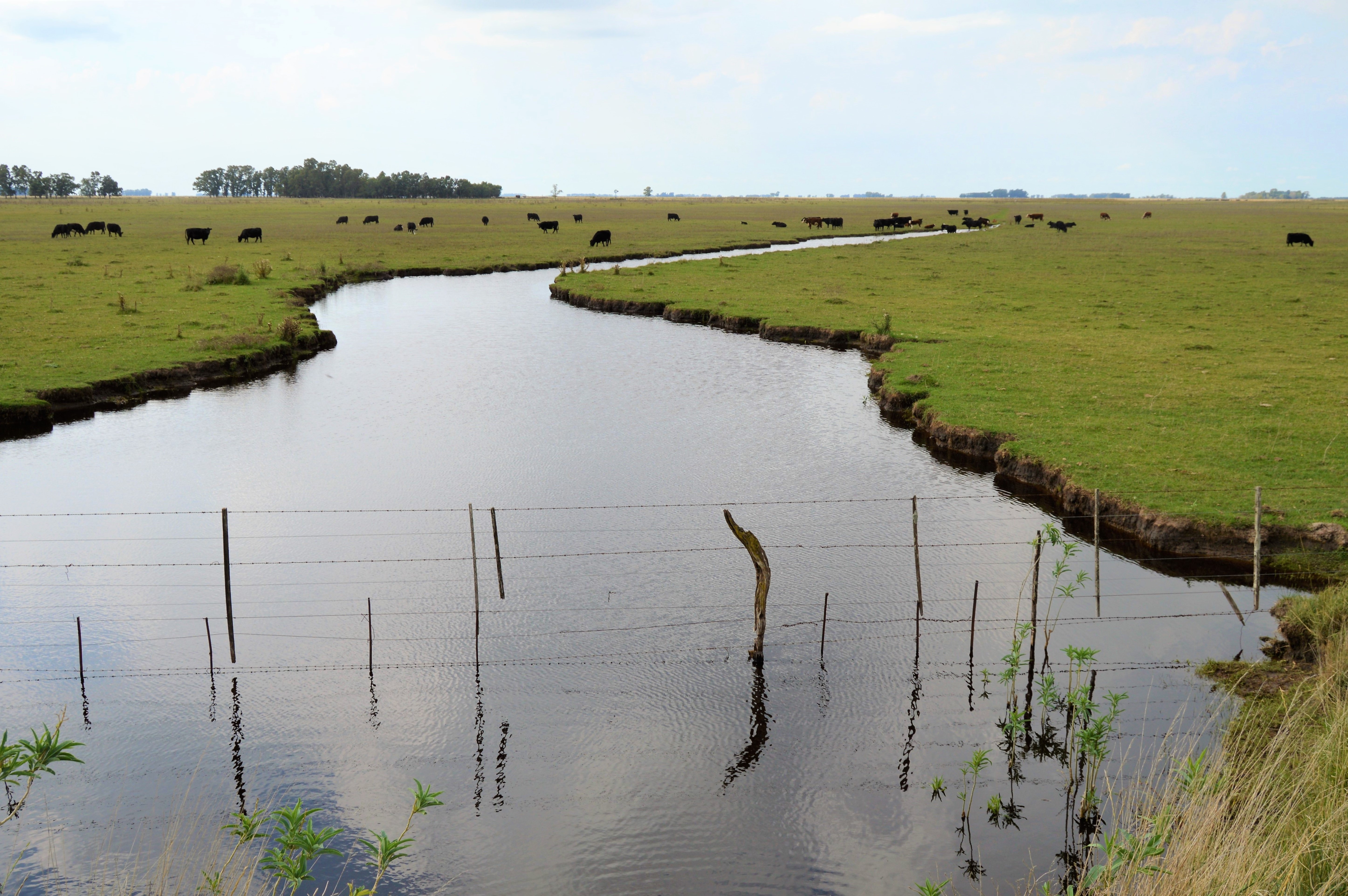Soil hydraulic properties database of the pampas region in Buenos Aires province
DOI:
https://doi.org/10.35305/curiham.ed24.e09Keywords:
INTA, Robust Soil Database, Pedotransfer Functions, Unsaturated Flow, Productive FlatlandsAbstract
Flatland areas, such as the Pampas in South America, rank among the world’s most economically productive landscapes. Over the last century, these regions have been increasingly used for intensive production, which has resulted in significant environmental impacts. These include alterations in pH, salinity, and other soil properties; changes in water flows and balances; increased floods and droughts; and heightened wind and water erosion. To address these challenges, numerical process-based models are essential to assess the highly variable, interconnected, and nonlinear processes that drive these impacts. Such models rely on comprehensive soil databases including hydraulic properties to provide representative results. This study aimed to develop a robust database of soil properties for the Buenos Aires Province in Argentina, encompassing much of the Pampas region. Using granulometric and physicochemical data from the Instituto Nacional de Tecnología Agropecuaria (INTA) database, we applied 38 pedotransfer functions to 381 soil profiles to estimate hydraulic parameters. These were compared with seven calibrated parameter sets from the different study sites. This study demonstrated that model performance varies depending on the evaluated function, with specific models excelling in particular variables, highlighting the need for careful selection based on the characteristics of the dataset.
Downloads
References
Ahuja, L. R., Cassel, D. K., Bruce, R. R. & Barnes, B. B. (1989). Evaluation of spatial distribution of hydraulic conductivity using effective porosity data. Soil Science, 148(6), 404–411. https://doi.org/10.1097/00010694-198912000-00002
Barranquero, R. S., Varni, M., Ruiz de Galarreta, A. & Banda Noriega, R. (14-15 de junio de 2012). Evaluación de las características del agua subterránea en la cuenca del arroyo Langueyú, Tandil, Buenos Aires, Argentina. 1er Encuentro de investigadores en Formación en Recursos Hídricos. Ezeiza, Buenos Aires, Argentina. https://www.researchgate.net/publication/319621092_Evaluacion_de_las_caracteristicas_del_agua_subterranea_en_la_cuenca_del_arroyo_Langueyu_Tandil_Buenos_Aires_Argentina
Bea, S. A., Wilson, S. A., Mayer, K. U., Dipple, G. M., Power, I. M. & Gamazo, P. (2012). Reactive Transport Modeling of Natural Carbon Sequestration in Ultramafic Mine Tailings. Vadose Zone Journal, 11(2), vzj2011.0053. https://doi.org/10.2136/vzj2011.0053
Bouyoucos, G. J. (1962). Hydrometer Method Improved for Making Particle Size Analyses of Soils1. Agronomy Journal, 54(5), 464–465. https://doi.org/10.2134/agronj1962.00021962005400050028x
Burgos, J. J. & Vidal, A. L. (1951). The Climates of the Argentine Retublic According to the New Thornthmaite Classification. Annals of the Association of American Geographers, 41(3), 237–263. https://doi.org/10.1080/00045605109352055
Campbell, G. S. & Shiozawa, S. (1992). Prediction of hydraulic properties of soils using particle-size distribution and bulk density data. In M. T. Van Genuchten, F. J. Leij and L. J. Lund (Eds.), Indirect Methods for Estimating the Hydraulic Properties of Unsaturated Soils: Proceedings of the International Workshop on Indirect Methods for Estimating the Hydraulic Properties of Unsaturated Soils, Riverside, California, October 11-13, 1989 (pp. 317–328). U. S. Salinity Laboratory, Agricultural Research Service, U. S. Department of Agriculture. https://books.google.com.ar/books?id=smVRAAAAMAAJ
Cosby, B. J., Hornberger, G. M., Clapp, R. B. & Ginn, T. R. (1984). A Statistical Exploration of the Relationships of Soil Moisture Characteristics to the Physical Properties of Soils. Water Resources Research, 20(6), 682–690. https://doi.org/10.1029/WR020i006p00682
Damiano, F. & Taboada, M. A. (2000). Prediccion del agua disponible usando funciones de pedo-transferencia en suelos agricolas de la region pampeana. Ciencia del suelo 18(2), 77–88. https://suelos.org.ar/publicaciones/vol_18n2/damiano_77-88.pdf
Golin, A. S., Páez Campos, H. R., Guevara Ochoa, C., Dávila, C. F. & Vives, L. S. (2024). Assessing open-access digital elevation models for hydrological applications in a large scale plain: Drainage networks, shallow water bodies and vertical accuracy. Earth Surface Processes and Landforms, 49(15), 5269–5283. https://doi.org/10.1002/esp.6035
Gülser, C. & Candemir, F. (2008). Prediction of Saturated Hydraulic Conductivity Using Some Moisture Constants and Soil Physical Properties. Proceeding Balwois, 1–5. https://www.researchgate.net/profile/Coskun-Guelser/publication/228839205_Prediction_of_Saturated_Hydraulic_Conductivity_Using_Some_Moisture_Constants_and_Soil_Physical_Properties/links/0c96053b16981075ab000000/Prediction-of-Saturated-Hydraulic-Conductivity-Using-Some-Moisture-Constants-and-Soil-Physical-Properties.pdf
Hillel, D., Krentos, V. D. & Stylianou, Y. (1972). Procedure and test of an internal drainage method for measuring soil hydraulic characteristics in situ. Soil Science, 114(5), 395–400. https://doi.org/10.1097/00010694-197211000-00011
Instituto Nacional de Tecnología Agropecuaria (2022, May 26). El INTA digitaliza las cartas de suelos de la Provincia de Buenos Aires. INTA Informa. https://intainforma.inta.gob.ar/el-inta-digitaliza-las-cartas-de-suelos-de-la-provincia-de-buenos-aires/
Jabro, J. D. (1992). Estimation of saturated hydraulic conductivity of soils from particle size distribution and bulk density data. Transactions of the American Society of Agricultural and Biological Engineers, 35(2), 557–560. https://doi.org/10.13031/2013.28633
Jaynes, D. B. & Tyler, E. J. (1984). Using soil physical properties to estimate hydraulic conductivity. Soil Science, 138(4), 298–305. https://doi.org/10.1097/00010694-198410000-00007
Jobbágy, E. G. & Jackson, R. B. (2007). Groundwater and soil chemical changes under phreatophytic tree plantations. Journal of Geophysical Research: Biogeosciences, 112, G02013. https://doi.org/10.1029/2006JG000246
Jobbágy, E. G., Tóth, T., Nosetto, M. D. & Earman, S. (2017). On the Fundamental Causes of High Environmental Alkalinity (pH ≥ 9): An Assessment of Its Drivers and Global Distribution. Land Degradation & Development, 28(7), 1973–1981. https://doi.org/10.1002/ldr.2718
Lavado, R. S. & Taboada, M. A. (2009). The Argentinean Pampas: A key region with a negative nutrient balance and soil degradation needs better nutrient management and conservation programs to sustain its future viability as a world agroresource. Journal of Soil and Water Conservation, 64(5), 150A–153A. https://doi.org/10.2489/jswc.64.5.150A
Mayer, K. U., Frind, E. O. & Blowes, D. W. (2002). Multicomponent reactive transport modeling in variably saturated porous media using a generalized formulation for kinetically controlled reactions. Water Resources Research, 38(9), 1174. https://doi.org/10.1029/2001WR000862
Mujica, C. R. (2020). Modelación numérica de los cambios hidrogeoquímicos en la zona no saturada del suelo sometida a distintos usos primarios en la región centro-sur bonaerense [Tesis de doctorado, Facultad de Ciencias Agrarias y Forestales de la Universidad Nacional de La Plata]. https://doi.org/10.13140/RG.2.2.26412.62085
Mujica, C. R., Bea, S. A., Jobbágy, E. G. (2021). Modeling soil chemical changes induced by grassland afforestation in a sedimentary plain with shallow groundwater. Geoderma, 400(2021), 115158. https://doi.org/10.1016/j.geoderma.2021.115158
Mujica, C. R., Milione, G. M., Bea, S. A. & Jobbágy, E. G. (2019). Modelación de los cambios químicos en suelos inducidos por la forestación de pastizales naturales en ecosistemas de llanura. Ecología Austral, 29(3), 433–445. https://doi.org/10.25260/EA.19.29.3.0.896
Oyarzabal, M., Clavijo, J., Oakley, L., Biganzoli, F., Tognetti, P., Barberis, I., Maturo, H. M., Aragón, R., Campanello, P. I., Prado, D., Oesterheld, M. & León, R. J. C. (2018). Unidades de vegetación de la Argentina. Ecología Austral 28(1), 040–063. https://doi.org/10.25260/ea.18.28.1.0.399
Podestá, G. P., Messina, C. D., Grondona, M. O. & Magrin, G. O. (1999). Associations between Grain Crop Yields in Central-Eastern Argentina and El Niño–Southern Oscillation. Journal of Applied Meteorology, 38(1), 1488–1498. https://doi.org/10.1175/1520-0450(1999)038<1488:ABGCYI>2.0.CO;2
Puckett, W. E., Dane, J. H. & Hajek, B. F. (1985). Physical and Mineralogical Data to Determine Soil Hydraulic Properties. Soil Science Society of America Journal, 49(4), 831–836. https://doi.org/10.2136/sssaj1985.03615995004900040008x
Rawls, W. J. & Brakensiek, D. L. (1989). Estimation of Soil Water Retention and Hydraulic Properties. In H. J. Morel-Seytoux (Ed.), Unsaturated Flow in Hydrologic Modeling. NATO ASI Series, Vol. 275. Springer, Dordrecht. https://doi.org/10.1007/978-94-009-2352-2_10
Rawls, W. J., Nemes, A., Pachepsky & Ya. (2004). Effect of soil organic carbon on soil hydraulic properties. Development in Soil Science, 30(2004), 95–114. https://doi.org/10.1016/S0166-2481(04)30006-1
Saxton, K. E. & Rawls, W. J. (2006). Soil Water Characteristic Estimates by Texture and Organic Matter for Hydrologic Solutions. Soil Science Society of America Journal, 70(5), 1569–1578. https://doi.org/10.2136/sssaj2005.0117
Schaap, M. G. (2004). Graphic user interfaces for pedotransfer functions. Developments in Soil Science, 30(2004), 349–356. https://doi.org/10.1016/S0166-2481(04)30019-X
Skaggs, T. H. (n.d.). Rosetta soil. GitHub. Retrieved January 2024 from https://github.com/usda-ars-ussl/rosetta-soil?tab=readme-ov-file
Soriano, A. (1992). Río de la Plata grasslands. In R. T. Coupland (Ed.), Natural grasslands: introduction and western hemisphere (pp. 367–407). Elsevier. https://cir.nii.ac.jp/crid/1570854175783394048
Sun, J., Wang, G., Sun, X., Sun, S., Guo, L., Hu, Z., Song, C. & Lin, S. (2024). Soil water dynamics and plant water uptake: Primeval mature vs. debris flow-developed half-mature subalpine fir stands in the eastern Tibetan Plateau. Science of the Total Environment, 951(2024), 175437. https://doi.org/10.1016/J.SCITOTENV.2024.175437
Taylor, K. E. (2001). Summarizing multiple aspects of model performance in a single diagram. Journal of Geophysical Research: Atmospheres, 106(D7), 7183–7192. https://doi.org/10.1029/2000JD900719
Teruggi, M. E. (1957). The Nature and Origin of Argentine Loess. Journal of Sedimentary Research, 27(3), 322–332. https://doi.org/10.1306/74D706DC-2B21-11D7-8648000102C1865D
van Genuchten, M. T. (1980). A closed-form equation for predicting the hydraulic conductivity of unsaturated soils. Soil Science Society of America Journal, 44(5), 892–898. https://doi.org/10.2136/sssaj1980.03615995004400050002x
Varni, M. R. & Usunoff, E. J. (1999). Simulation of regional-scale groundwater flow in the Azul River basin, Buenos Aires Province, Argentina. Hydrogeology Journal, 7, 180–187. https://doi.org/10.1007/s100400050190
Vereecken, H., Maes, J. & Feyen, J. (1990). Estimating unsaturated hydraulic conductivity from easily measured soil properties. Soil Science, 149(1), 1–12. https://doi.org/10.1097/00010694-199001000-00001
Weinzettel, P. (2005). Hidrodinámica de la zona no saturada en suelos argiudoles de la cuenca del arroyo Azul. [Tesis de doctorado no publicada]. Universidad Nacional del Sur.
Wösten, J. H. M., Lilly, A., Nemes, A. & Le Bas, C. (1999). Development and use of a database of hydraulic properties of European soils. Geoderma, 90(3–4), 169–185. https://doi.org/10.1016/S0016-7061(98)00132-3
Wösten, J. H. M., Pachepsky, Ya. A. & Rawls, W. J. (2001). Pedotransfer functions: Bridging the gap between available basic soil data and missing soil hydraulic characteristics. Journal of Hydrology, 251(3–4), 123–150. https://doi.org/10.1016/S0022-1694(01)00464-4
Zárate, M. A. (2003). Loess of southern South America. Quaternary Science Reviews, 22(18–19), 1987–2006. https://doi.org/10.1016/S0277-3791(03)00165-3
Zárate, M. A., Tripaldi, A. (2012). The aeolian system of central Argentina. Aeolian Research, 3(4), 401–417. https://doi.org/10.1016/j.aeolia.2011.08.002
Zimmermann, E. D. & Basile, P. A. (2007, May 15). Funciones hidráulicas de suelos limosos: regresiones no lineales con propiedades físicas y granulométricas. XXIº Congreso Nacional del Agua, San Miguel de Tucumán, Argentina. https://www.fceia.unr.edu.ar/curiham/es/wp-content/uploads/2018/11/con10-CNA071.pdf
Zimmermann, E. D. & Basile, P. A. (2008). Uso de funciones de pedotransferencia para la estimación de parámetros hidráulicos en suelos limosos (Llanura Argentina). Boletín geológico y minero, 119(1), 71–80. https://web.igme.es/boletin/2008/119_1_2008/ARTICULO%206.pdf
Zimmermann, E. D. & Basile, P. A. (2011). Estimación de parámetros hidráulicos en suelos limosos mediante diferentes funciones de pedotransferencia. Tecnología y ciencias del agua, 2(1), 99-116. https://www.scielo.org.mx/scielo.php?pid=S2007-24222011000100007&script=sci_arttext
Published
How to Cite
Issue
Section
License

This work is licensed under a Creative Commons Attribution-NonCommercial-ShareAlike 4.0 International License.



























